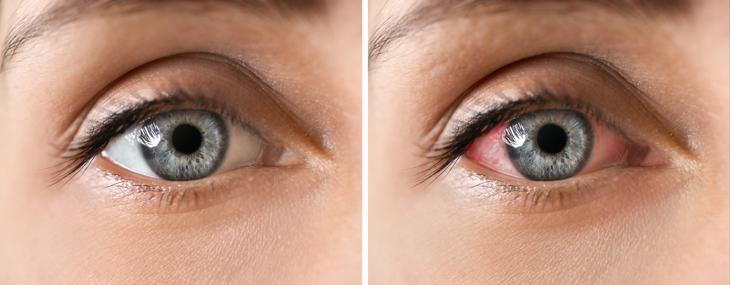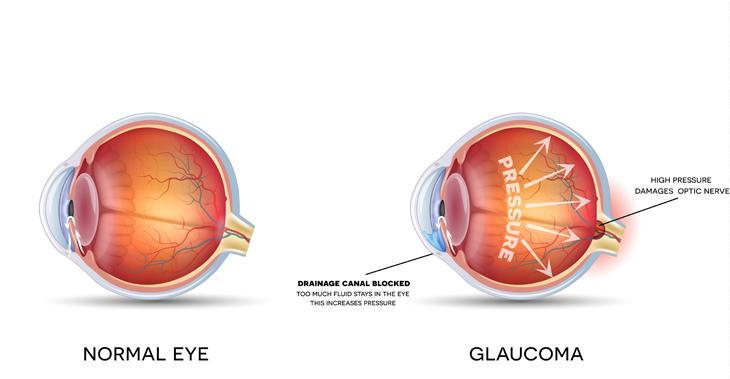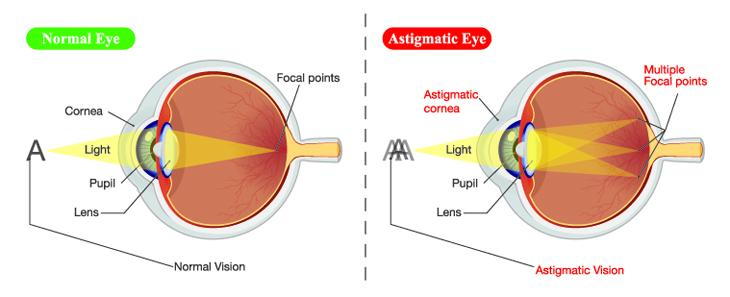
Eye conditions and diseases can affect your vision and overall quality of life. Fortunately, eye specialists see these conditions regularly and can intervene as necessary to preserve your sight for as long as possible. So which eye conditions and diseases are common? Let's discuss!
Macular Degeneration
Up to 11 million individuals may develop some form of macular degeneration. Macular degeneration is an eye issue that causes blurry vision and will decrease your central vision. You may notice that you have difficulty driving and reading. You could struggle with facial recognition.
It occurs when your macula, the portion of your retina responsible for a majority of your color vision, begins to thin. In most cases, this problem happens in people who are 60 or older.
You could have it in one or both eyes. It, however, will eventually affect both eyes. Since it doesn't affect all of your vision, you may maintain your peripheral vision and only experience loss in your central vision.
With early detection, you can slow the progression of macular degeneration's irreversible vision loss.
Diabetic Retinopathy
Around 4.1 million people have diabetic retinopathy. Approximately one out of every 29 people have this condition. Of diabetics, almost all type I diabetics end up with this condition, while around 60 percent of type II diabetics develop it.
Diabetic retinopathy is a condition that damages the blood vessels in your retina, the light-sensitive cells in the back of your eye. It arises when uncontrolled blood sugar levels damage the tiny blood vessels.
Initially, you may only experience a minor change in your vision. However, as this condition advances, your vision may fluctuate, or you may have blurred vision. Floaters could develop. The issue is when spots, strings, or other shapes travel in your visual field. You could also have vision loss or notice dark or empty spaces in your field of vision.
Managing your blood sugar well can reduce the possibility of this condition. In the early stages, monitoring can be enough. As it progresses, though, your optometrist may recommend laser treatment, medication, or another surgical procedure.
Glaucoma

More than three million Americans have glaucoma, as noted by the Glaucoma Research Foundation. A high percentage, 2.7 million to be exact, are 40 or older and have open-angle glaucoma, an eye problem that can lead to blindness. In fact, glaucoma is one of the leading causes of blindness in people over 60.
Glaucoma describes a condition that occurs when you sustain damage to your optic nerve. In most cases, you have higher-than-normal eye pressure, which damages the nerve.
Although several types of glaucoma exist, there are two main types -- open-angle and acute angle-closure. Open-angle causes patchy spots to develop in your central or peripheral vision. Often, it affects both of your eyes. As it worsens, you may develop tunnel vision, which is when you lose your peripheral vision.
On the other hand, acute angle-closure glaucoma is a medical emergency. With this condition, you may have severe headaches, nausea, vomiting, and eye pain. Some people develop blurred vision, see halos around lights, and will notice their eyes are red.
Any vision loss from glaucoma is permanent. Therefore, you should visit your optometrist regularly for routine examinations. At appointments, your optometrist can intervene early with eye drops or oral medication to slow the progression. When the condition worsens, your doctor can refer you for surgery.
Cataracts
Over 24.4 million Americans who are aged 40 and above have cataracts. The risk increases with age.
The term "cataracts" describes a clouding over the lens of the eye. The lens is a clear portion inside the eye that helps the eye to focus. The clouding makes the person feel like they're looking out of a fogged-up window.
Initially, you may not have any signs of cataracts. The onset is usually slow. However, once you do have symptoms, you could experience dim, blurred, or clouded vision. A cataract could interfere with your ability to see at night.
Cataracts can make you more sensitive to glare and light. You could also see halos around light or notice that colors look faded or more yellow. Before you receive a formal diagnosis, you might notice that your eyewear prescription changes frequently.
Early on, treatment will consist of corrective eyewear to optimize your vision. Once it advances, you could need surgery.
Refractive Errors

Refractive errors rank as the most common vision problem. In fact, over 150 million Americans have a refractive error.
This vision problem occurs when your eye isn't shaped exactly like a ball. The odd shape causes light to enter your eye and not focus directly on the retina, leading to blurred vision when looking at objects up close, far away, or possibly both.
Nearsightedness, for example, is when you have a refractive error that causes you to not be able to see far away. Farsightedness occurs when objects close up look blurry.
Astigmatism describes when your eye is shaped more like a football than a ball. When the light enters, it doesn't reflect in front of or behind your retina like with nearsightedness or farsightedness. Instead, the light scatters when it enters your eye and causes your vision to appear blurry, possibly both up close and far away.
Presbyopia is another refractive error, and it arises when you age. With this eye issue, you have difficulty seeing up close.
Glasses and contacts are the standard treatment for refractive errors. An optometrist will identify your prescription and ensure you receive the one that optimizes your vision the most. You could also choose to have laser eye surgery to correct your vision deficit.
An optometrist can determine if you qualify for the procedure and then refer you to a well-respected eye surgeon who performs the procedure.
These are merely the most common types of eye conditions and diseases. An optometrist is trained in the detection and treatment of these and others. Getting routine eye exams can help with the management of your chronic eye problems.

Eye conditions and diseases can affect your vision and overall quality of life. Fortunately, eye specialists see these conditions regularly and can intervene as necessary to preserve your sight for as long as possible. So which eye conditions and diseases are common? Let's discuss!
Macular Degeneration
Up to 11 million individuals may develop some form of macular degeneration. Macular degeneration is an eye issue that causes blurry vision and will decrease your central vision. You may notice that you have difficulty driving and reading. You could struggle with facial recognition.
It occurs when your macula, the portion of your retina responsible for a majority of your color vision, begins to thin. In most cases, this problem happens in people who are 60 or older.
You could have it in one or both eyes. It, however, will eventually affect both eyes. Since it doesn't affect all of your vision, you may maintain your peripheral vision and only experience loss in your central vision.
With early detection, you can slow the progression of macular degeneration's irreversible vision loss.
Diabetic Retinopathy
Around 4.1 million people have diabetic retinopathy. Approximately one out of every 29 people have this condition. Of diabetics, almost all type I diabetics end up with this condition, while around 60 percent of type II diabetics develop it.
Diabetic retinopathy is a condition that damages the blood vessels in your retina, the light-sensitive cells in the back of your eye. It arises when uncontrolled blood sugar levels damage the tiny blood vessels.
Initially, you may only experience a minor change in your vision. However, as this condition advances, your vision may fluctuate, or you may have blurred vision. Floaters could develop. The issue is when spots, strings, or other shapes travel in your visual field. You could also have vision loss or notice dark or empty spaces in your field of vision.
Managing your blood sugar well can reduce the possibility of this condition. In the early stages, monitoring can be enough. As it progresses, though, your optometrist may recommend laser treatment, medication, or another surgical procedure.
Glaucoma

More than three million Americans have glaucoma, as noted by the Glaucoma Research Foundation. A high percentage, 2.7 million to be exact, are 40 or older and have open-angle glaucoma, an eye problem that can lead to blindness. In fact, glaucoma is one of the leading causes of blindness in people over 60.
Glaucoma describes a condition that occurs when you sustain damage to your optic nerve. In most cases, you have higher-than-normal eye pressure, which damages the nerve.
Although several types of glaucoma exist, there are two main types -- open-angle and acute angle-closure. Open-angle causes patchy spots to develop in your central or peripheral vision. Often, it affects both of your eyes. As it worsens, you may develop tunnel vision, which is when you lose your peripheral vision.
On the other hand, acute angle-closure glaucoma is a medical emergency. With this condition, you may have severe headaches, nausea, vomiting, and eye pain. Some people develop blurred vision, see halos around lights, and will notice their eyes are red.
Any vision loss from glaucoma is permanent. Therefore, you should visit your optometrist regularly for routine examinations. At appointments, your optometrist can intervene early with eye drops or oral medication to slow the progression. When the condition worsens, your doctor can refer you for surgery.
Cataracts
Over 24.4 million Americans who are aged 40 and above have cataracts. The risk increases with age.
The term "cataracts" describes a clouding over the lens of the eye. The lens is a clear portion inside the eye that helps the eye to focus. The clouding makes the person feel like they're looking out of a fogged-up window.
Initially, you may not have any signs of cataracts. The onset is usually slow. However, once you do have symptoms, you could experience dim, blurred, or clouded vision. A cataract could interfere with your ability to see at night.
Cataracts can make you more sensitive to glare and light. You could also see halos around light or notice that colors look faded or more yellow. Before you receive a formal diagnosis, you might notice that your eyewear prescription changes frequently.
Early on, treatment will consist of corrective eyewear to optimize your vision. Once it advances, you could need surgery.
Refractive Errors

Refractive errors rank as the most common vision problem. In fact, over 150 million Americans have a refractive error.
This vision problem occurs when your eye isn't shaped exactly like a ball. The odd shape causes light to enter your eye and not focus directly on the retina, leading to blurred vision when looking at objects up close, far away, or possibly both.
Nearsightedness, for example, is when you have a refractive error that causes you to not be able to see far away. Farsightedness occurs when objects close up look blurry.
Astigmatism describes when your eye is shaped more like a football than a ball. When the light enters, it doesn't reflect in front of or behind your retina like with nearsightedness or farsightedness. Instead, the light scatters when it enters your eye and causes your vision to appear blurry, possibly both up close and far away.
Presbyopia is another refractive error, and it arises when you age. With this eye issue, you have difficulty seeing up close.
Glasses and contacts are the standard treatment for refractive errors. An optometrist will identify your prescription and ensure you receive the one that optimizes your vision the most. You could also choose to have laser eye surgery to correct your vision deficit.
An optometrist can determine if you qualify for the procedure and then refer you to a well-respected eye surgeon who performs the procedure.
These are merely the most common types of eye conditions and diseases. An optometrist is trained in the detection and treatment of these and others. Getting routine eye exams can help with the management of your chronic eye problems.
Locations
Primary Location
5550 Morehouse Dr.
San Diego, CA 92121, US
